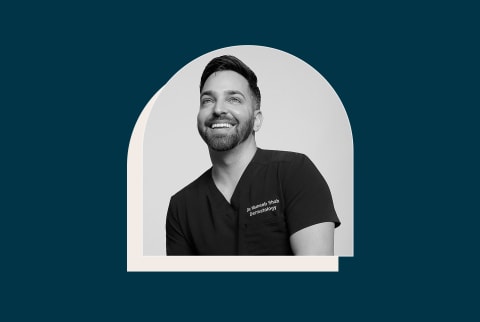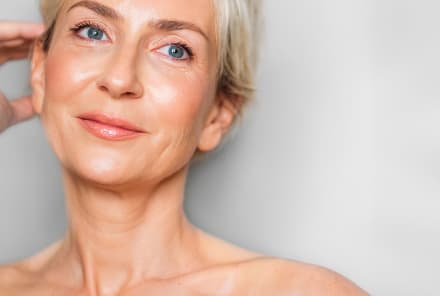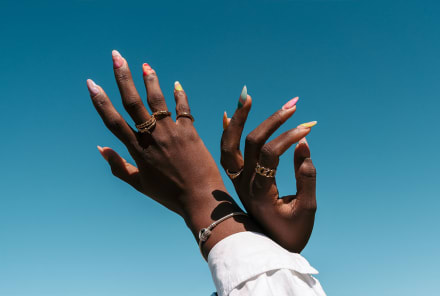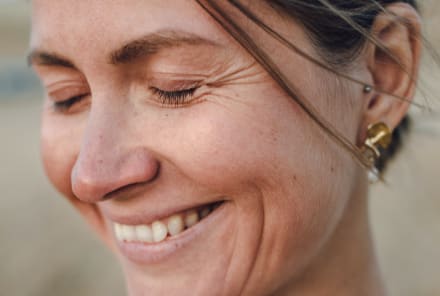Advertisement
Tune In: How To Treat Stubborn Dark Spots & More With Top Derm Muneeb Shah, DO


If you're on Instagram, TikTok, or YouTube, you know our guest today. As the face behind the viral sensation Doctorly, board-certified dermatologist Muneeb Shah, D.O., often shares his best product recommendations and tips for the masses' most pressing skin care concerns. Things like enlarged pores, dark spots, fine lines, sunscreen recs, in-office treatments, and the list goes on.
What makes Shah's approach so, well, approachable is his results-driven attitude. For Shah, what makes a product great isn't just about what the packaging looks like, price point, or experience—it's whether it's actually going to achieve what the claims say.
"When I started getting into skin care myself, I was like 'I have this texture, these bumps, and I'm starting to develop fine lines; what are the things I can buy?' It's always been very problem-solution focused," he says, noting this was the inspiration behind his new brand Remedy. "If we understand how to get these concerns, then we can understand what ingredients to look for in a product, and then we can find the right products to really help with that."
In the episode we touch on a few skin care concerns but spend a good amount of time homing in on one problem that seems to be ever present in people's minds: dark spots.
How a top derm approaches dark spot treatments
As Shah notes, it's important to understand why something is happening so we can better identify solutions. He identifies the three main triggers of dark spots:
- Hormones: "With something like melasma, hormones can trigger dark spots—be that during pregnancy or other spikes," he says.
- Sun exposure: "Sun exposure activates melanocytes to produce melanin," he says.
- Inflammation: "Any inflammation—like from acne—is going to cause those melanocytes to basically dump melanin into your skin, and those are going to appear as dark spots," he says.
So, one of these three things needs to be present to kick off the dark spot cycle. And once that cycle has begun, a few things start happening below the surface, which is what creates the excess melanin.
"When we look at what creates melanin in the skin, there are really three steps that happen. There's an enzyme called tyrosine that creates melanin—that's the first step.
But those melanin granules are still in the melanocytes when it's created by the enzyme, but then there's melanosome that's like a little vehicle that transfers the melanin to the cell. Finally, it deposits it into your keratinocytes," explains Shah.
So clearly explained, no?
The dark spot treatment pyramid
To address dark spots, Shah's dark spot treatment pyramid was introduced. Just begin at the foundation of the pyramid and work your way up to the top.
"The very bottom of the pyramid that's holding everything together is sunscreen. The next step up on that pyramid is targeted ingredients [that address the melanin formation process]. And the next step up, that's when treatments come into play."
While this is hopefully well understood at this point, to reiterate: Sunscreen prevents UV damage, which is the No. 1 cause of premature aging, such as dark spots. It also protects the skin from cancers, such as melanoma. So, regardless of aesthetic concerns, it should be worn regularly.
"No matter what treatment you use, whether it's a laser or a topical treatment or a prescription treatment, none of them are going to work very effectively if you're not protecting yourself from those hyper-activated melanocytes," he says. "Specifically a tinted sunscreen, because tinted sunscreens have the ability to block visible light, uh, whereas a traditional sunscreen doesn't block visible light."
But as for the target ingredients (or the second step of the pyramid), Shah breaks that down for us:
- Retinol: "The only, only ingredient that targets all three steps is actually retinol. Retinol will target both the creation, the passing, and the deposition of pigment once it's already formed," he says.
- Tyrosinase inhibitors: Kojic acid, arbutin, tranexamic acid, niacinamide, acetylglucosamine, soy, and licorice root.
- Exfoliators: "When the pigments are deposited in the skin, you really need exfoliants or things that are going to turn over those skin cells to remove them," he says. "So those are retinol and exfoliating acids like mandelic acid, glycolic acid, salicylic acid."
Remedy For Dark Spots strategically includes all three, which are formulated in such a way that they work synergistically.
Then, for those who have access and the means to get more advanced treatments, there are in-office options. "Once you've got a good skin care, good foundational routine, that's when you step up to getting in-office procedures. That's where you're really going to break through any plateaus that you have in the skin," Shah says.
Some options:
- Clear and Brilliant: "A lot of dermatologists will recommend this. It's an incredible laser that can target pigment really effectively that's safe for all skin tones," he says.
- Fraxel: "This is very effective for pigment," he says.
- Pico: "This is for really stubborn pigmentation," he says.
- IPL or BBL: "If you have a much lighter skin tone—like a Fitzpatrick one or two—IPL or BBL can be very helpful. But with darker skin tones it can cause burns," he says.
- Chemical peels
- Microneedling
Tune in:
Beyond dark spots, Shah dives into retinol use, enlarged pores, wrinkles, and how to care for the skin through lifestyle changes. Listen to the entire conversation here.











